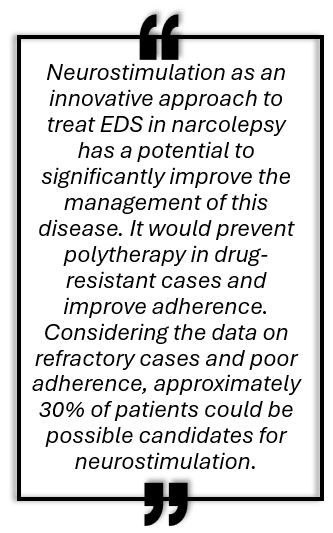Vagus Nerve Stimulation Shows Promise Against Daytime Sleepiness in Narcolepsy: Novel Study
The effect of vagus nerve stimulation persons with narcolepsy revealed a specific, notable improvement in daytime sleepiness in a novel open-label study.
Newly published in the Brain Stimulation Journal, a first of its kind open-label prospective comparative study assessing vagus nerve stimulation (VNS) showed significant improvement in daytime sleepiness among patients with narcolepsy, suggesting that this type of neurostimulation could be a promising nonmedical treatment for the condition.

Among 36 patients compared with the baseline (Epworth Sleepiness Scale [ESS], 15.9; ±2.5), the group of patients with narcolepsy (n = 18) showed a significant improvement on ESS after 3 months (ESS, 11.2; ±3.3; P < .05) and 6 months (ESS, 9.6; ±2.8; P < .001) on VNS therapy. The investigators did not observe a significant ESS-improvement in patients without narcolepsy who received VNS treatment (n = 18) (baseline, 14.9 [±3.9]; 3 months, 13.6 [±3.7]; 6 months, 13.2 [±3.5]; P = .2).
“We intentionally compared patients with narcolepsy and patients without narcolepsy experiencing daily sleepiness in this study in order to detect the possible disease-specific effect of VNS in narcolepsy. Comparison of VNS with the best medical treatment in narcolepsy was out of the scope of our study,” senior author Sergiu Groppa, MD, PhD, professor of neurology at University Medical Center of the Johannes Gutenberg University Mainz, Germany, and colleagues wrote.
“Interestingly, the effect on ESS was specific for the patients with narcolepsy, since no statistically significant changes were observed in patients without narcolepsy. The attested improvement in daytime sleepiness was independent from the antidepressant effect of VNS. It is worth to mention that the positive effects of VNS on daytime sleepiness in patients with narcolepsy were more notable with increased duration of VNS.”
“Interestingly, the effect on ESS was specific for the patients with narcolepsy, since no statistically significant changes were observed in patients without narcolepsy. The attested improvement in daytime sleepiness was independent from the antidepressant effect of VNS. It is worth to mention that the positive effects of VNS on daytime sleepiness in patients with narcolepsy were more notable with increased duration of VNS.”
Investigators evaluated the therapeutic effect of VNS on daily sleepiness and cataplexies in narcolepsy. In this study, patients with narcolepsy who were treated with VNS because of depression or epilepsy were compared with controls without narcolepsy treated with VNS for depression or epilepsy (mean age, 31.5 years; ±8.2). The investigators assessed daily sleepiness using ESS and weekly cataplexy rate (WCR) before the implantation of VNS and at 3- and 6-month follow-ups.
Indication for VNS implantation was epilepsy in 22 patients (61.1 %) and depression in 14 patients (38.9 %). There were 10 patients who had narcolepsy type 1 (NT1; 55.6 %) and 8 patients who had narcolepsy type 2 (NT2; 44.4 %). Those with narcolepsy received medications including modafinil in 8 (44.4 %), methylphenidate in 3 (16.7 %), pitolisant in 7 (38.9 %), solriamfetol in 4 (22.2 %), sodium oxybate in 4 (22.2%), selective serotonin reuptake inhibitors in 5 (27.8 %), and clomipramine in 2 (11.1 %).
FINDINGS
Among the patients with narcolepsy, investigators observed a trend in improvement of number of cataplexies per week following 6 months (WCR, 1.8; ±2.1) compared with baseline (WCR, 3.9; ±4.5). Despite this observation, it did not reach a statistically significant difference (P = .09) in this set of patients. In addition, the mean WCR after 3 months with VNS was 2.8 (±3.1) in those with narcolepsy and did not differ from baseline. Notably, investigators did not observe any differences between the study groups with adverse effects.

“Neurostimulation as an innovative approach to treat EDS in narcolepsy has a potential to significantly improve the management of this disease. It would prevent polytherapy in drug-resistant cases and improve adherence,” Groppa et al noted. “Considering the data on refractory cases and poor adherence, approximately 30% of patients could be possible candidates for neurostimulation. In addition, teratogenic effects of medication could be avoided by the use of neurostimulation in pregnancy. Further investigation of neurostimulation in narcolepsy could provide new ways to treat this disease and to search for synergistic effects of medication in combination with neurostimulation as it is already being done in epilepsy.”
All told, data collection was not blinded, and a sham-controlled group was not included in the study, providing only class 3 evidence. The authors also noted that challenge with selection of patients with narcolepsy and the 2 other conditions, epilepsy and depression, in which VNS treatment is only approved for. According to the author’ knowledge, this is the first study that could successfully recruit these patients but those included were not enough to perform subgroup analyses for NT1 and NT2.
“In conclusion, VNS could be a safe complementary treatment option for patients with narcolepsy who did not respond to drug treatment. Our data suggest a positive effect of VNS on daytime sleepiness in patients with narcolepsy of both types. Our open-label study should motivate future randomized sham-controlled studies on VNS in narcolepsy,” Groppa et al noted.